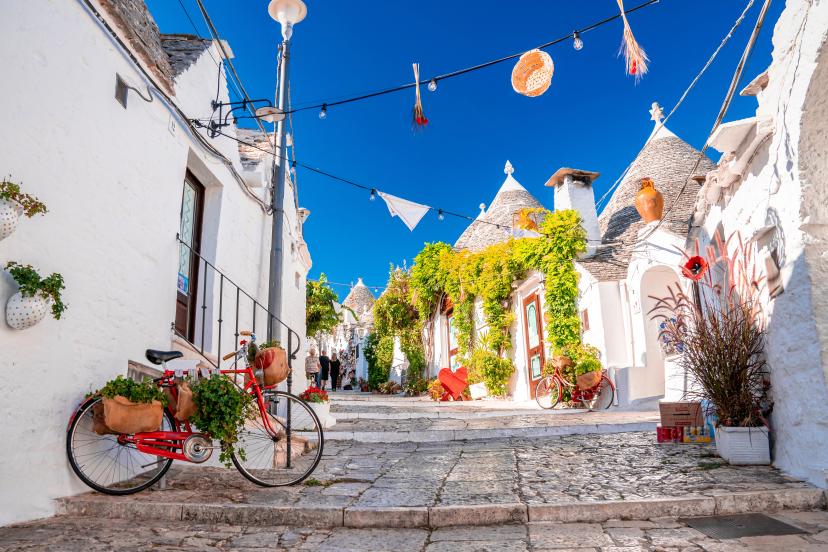Cycling Puglia from Start to Finish
Your ultimate guide to cycling Puglia — covering the best routes, when to go, must-see trulli houses, coastal classics, and the key highlights every cyclist should know.
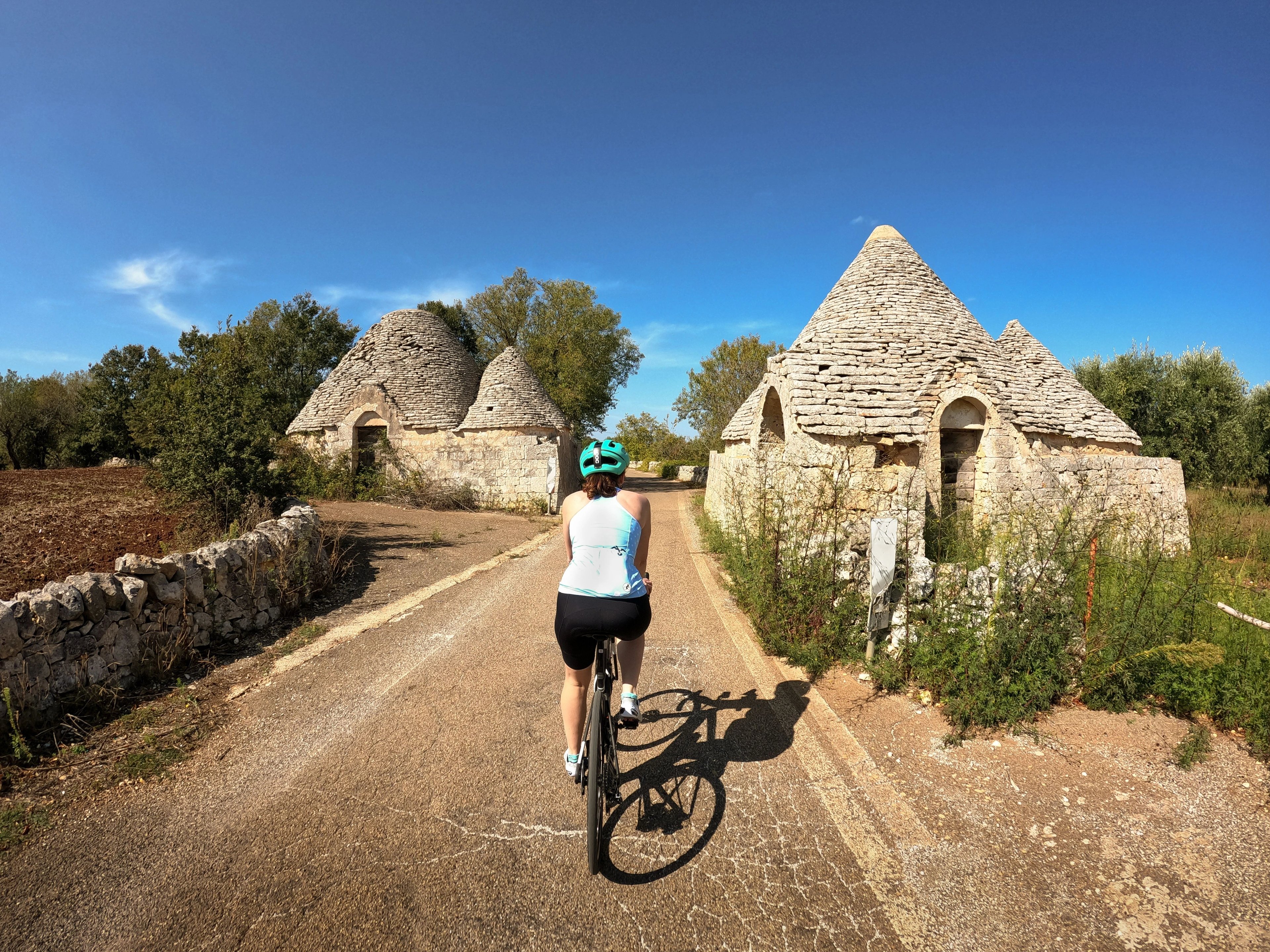
Quick links
Puglia — the long, sun-drenched heel of Italy’s boot — has become one of Europe’s most appealing destinations for cyclists.
With more than 800 km of coastline, a predominantly flat to gently rolling terrain, and a network of quiet rural roads winding through olive groves, vineyards, and whitewashed hill towns, the region offers ideal conditions for both leisurely riders and dedicated road cyclists.
This guide provides a comprehensive overview of everything a cyclist needs to plan and enjoy a cycling trip in Puglia.
It covers terrain characteristics, weather, route recommendations, safety considerations, transportation, bike rental, local culture, and practical information on food, water, logistics, and rest stops.
Let’s dive in!
Puglia as a cycling destination
Geographic Overview
Puglia occupies Italy’s southeastern peninsula between the Adriatic Sea (east) and the Ionian Sea (southwest).
It is composed of six provinces — Bari, Brindisi, Taranto, Lecce, Foggia, and Barletta-Andria-Trani — each offering distinct landscapes for cyclists.
.png&w=2048&q=85)
The region is primarily flat and low-lying, with the exception of two upland areas:
The Murge Plateau — a karst limestone region with rolling uplands and agricultural landscapes.
The Gargano Promontory — a forested, mountainous peninsula in northern Puglia with steep climbs and coastal switchbacks.
Outside these two regions, elevations remain modest, making the majority of routes accessible to cyclists of all fitness levels.

What Makes it Ideal for Cycling
Puglia has become one of Italy’s most attractive cycling regions thanks to a combination of its climate, landscape, and overall accessibility.
The region offers an experience that suits both recreational cyclists and more experienced riders aiming for longer touring days.
Several factors contribute to its growing popularity:
Low traffic in rural areas: Narrow country roads and strade bianche (white gravel roads) dominate the inland landscape.
A long cycling season: Mild winters, early springs, and warm autumns allow cycling almost year-round.
Varied scenery: Riders experience trulli villages, olive groves, vine-covered hills, cliffs, and beaches — often within a single ride.
Short distances between towns: Ideal for touring, food stops, and regular sightseeing breaks.
Cyclist-friendly cuisine: Fresh produce, pasta, seafood, and local fruits make refuelling easy and enjoyable.
Accessible terrain: Much of the region is flat or gently undulating, making it welcoming for recreational cyclists and e-bike users.
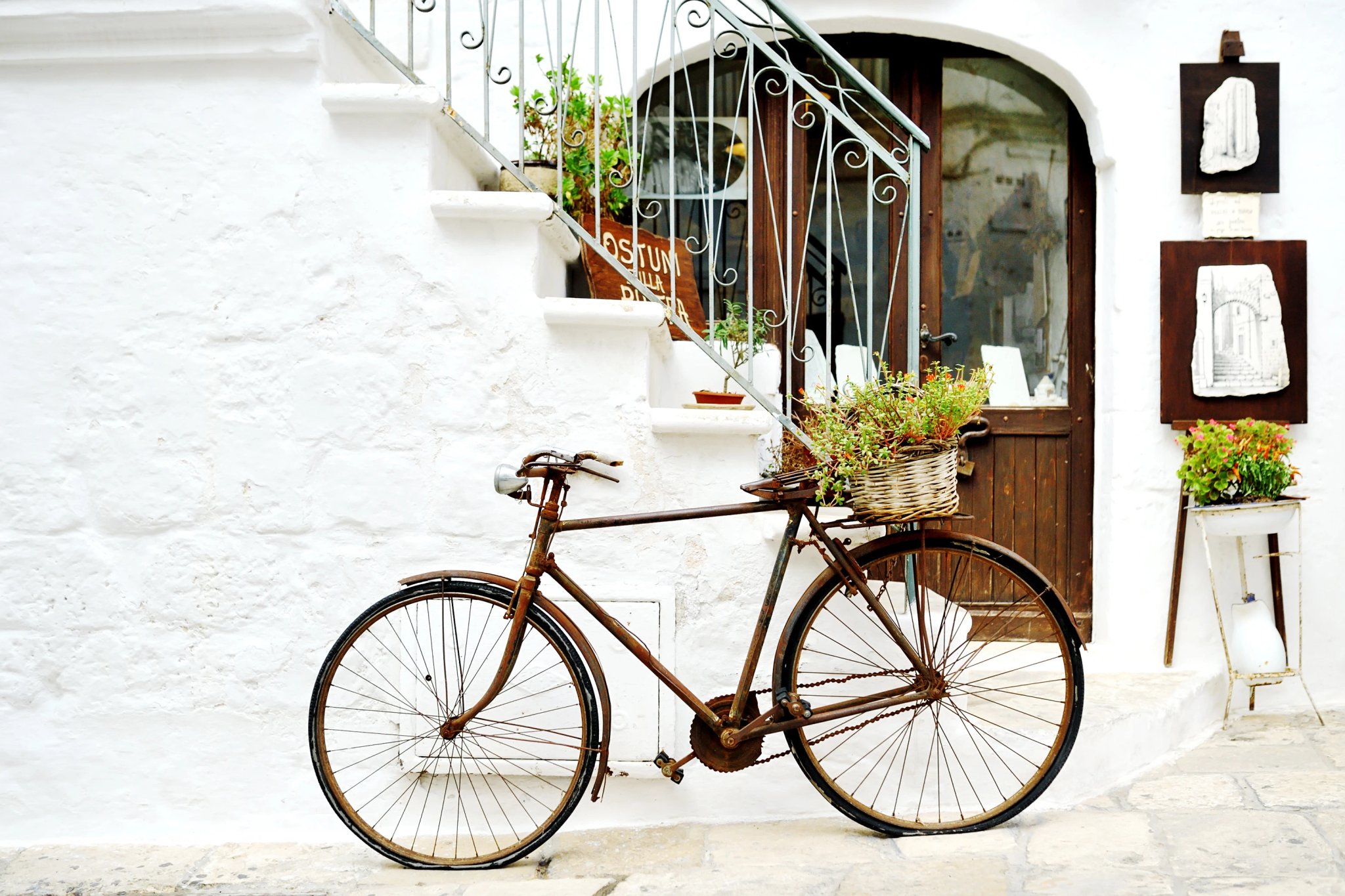
Types of Cycling
Puglia offers a wide variety of cycling experiences thanks to its mix of flat coastal stretches, gently rolling inland hills, and extensive networks of rural roads. Whether you’re a road cyclist seeking smooth, uninterrupted riding, or a family looking for relaxed seaside paths, the region’s landscape accommodates every level and style of cyclist.
What defines rides for each type:
Road Cycling: Smooth asphalt roads across flat or rolling terrain.
E-Bike Touring: Increasingly popular, especially for longer routes or hilly stretches around Valle d’Itria.
Gravel Riding: Widespread strade bianche and karst terrain make Puglia ideal for gravel cyclists.
Leisure and Family Cycling: Flat sections in Salento and coastal promenades suit casual riders.

When to Go
Puglia enjoys one of the longest and most reliable cycling seasons in Italy. With warm springs, bright autumns, and mild coastal winters, the region offers comfortable riding conditions for much of the year.
March–June: Optimal cycling weather across the region
July–August: Hot inland — start early or stick to coastal roads
September–October: Excellent top season with warm temperatures and quieter roads
November–February: Mild but less predictable weather, best for coastal routes
Below is an overview of what to expect in each season so you can plan your trip with confidence.
Spring (March–May)
Spring is one of the best times to cycle in Puglia. The landscape is green, wildflowers bloom across the countryside, and temperatures are warm without the intensity of summer. Roads are quieter, and the fresh air makes longer rides enjoyable.
Temperatures: 13–22°C
Best for: All cyclists — ideal balance of warmth, daylight, and comfort
Why ride in spring:
Perfect temperatures
Longer days
Lush countryside and clear coastal views
Ideal for both coastal and inland routes
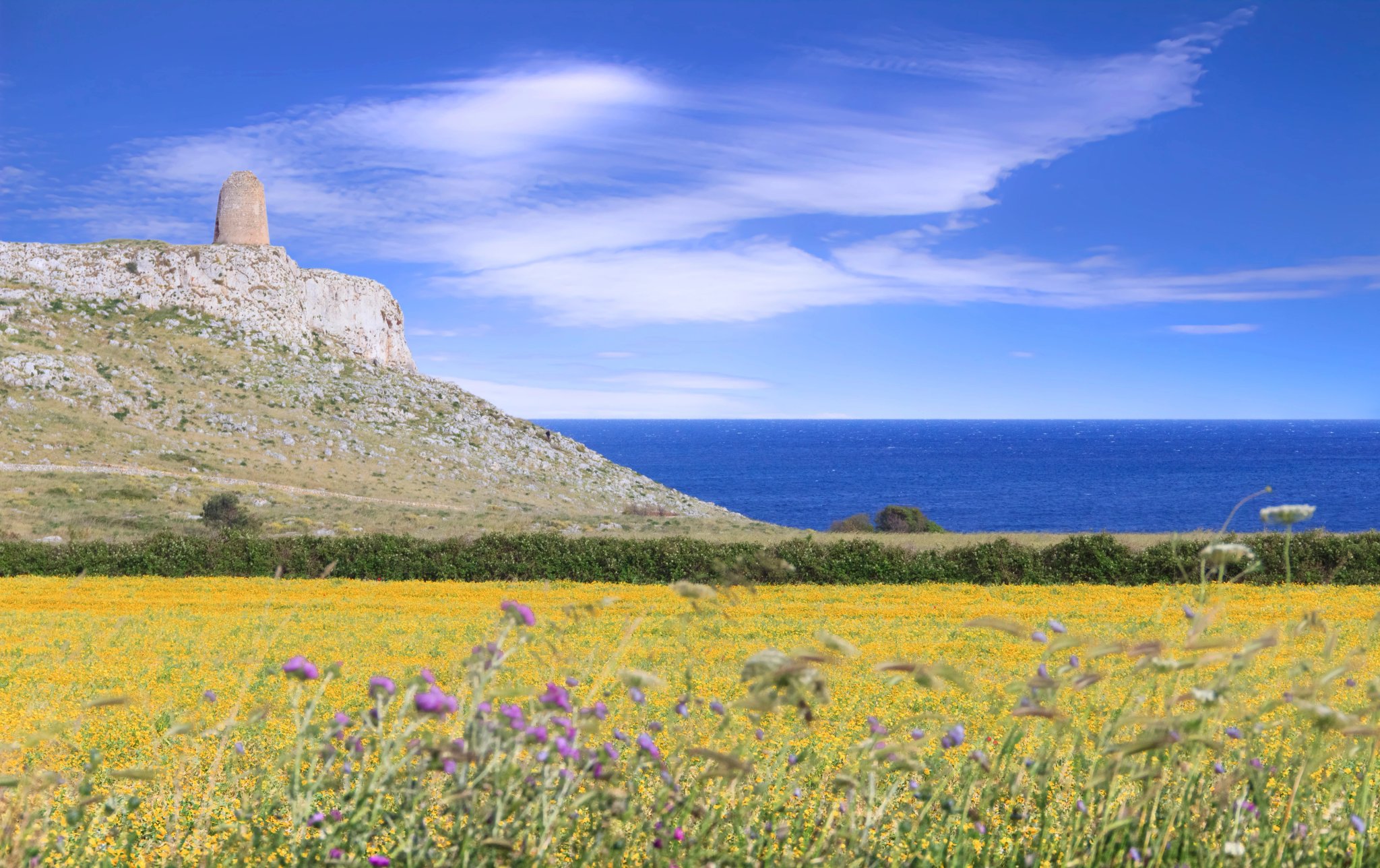
Summer (June–August)
Summer in Puglia is beautiful but hot, especially inland. If you plan to ride during this time, start early. Coastal breezes help, but midday heat and increased beach traffic can make long rides challenging.
Temperatures: 28–36°C (hotter inland)
Best for: Early-morning riders, coastal routes, shorter days
Good to know:
Choose coastal routes over inland ones
Start rides early to avoid the midday heat
Expect more tourists near beaches
If you prefer cooler climbs and quieter rides, visit earlier or later in the year
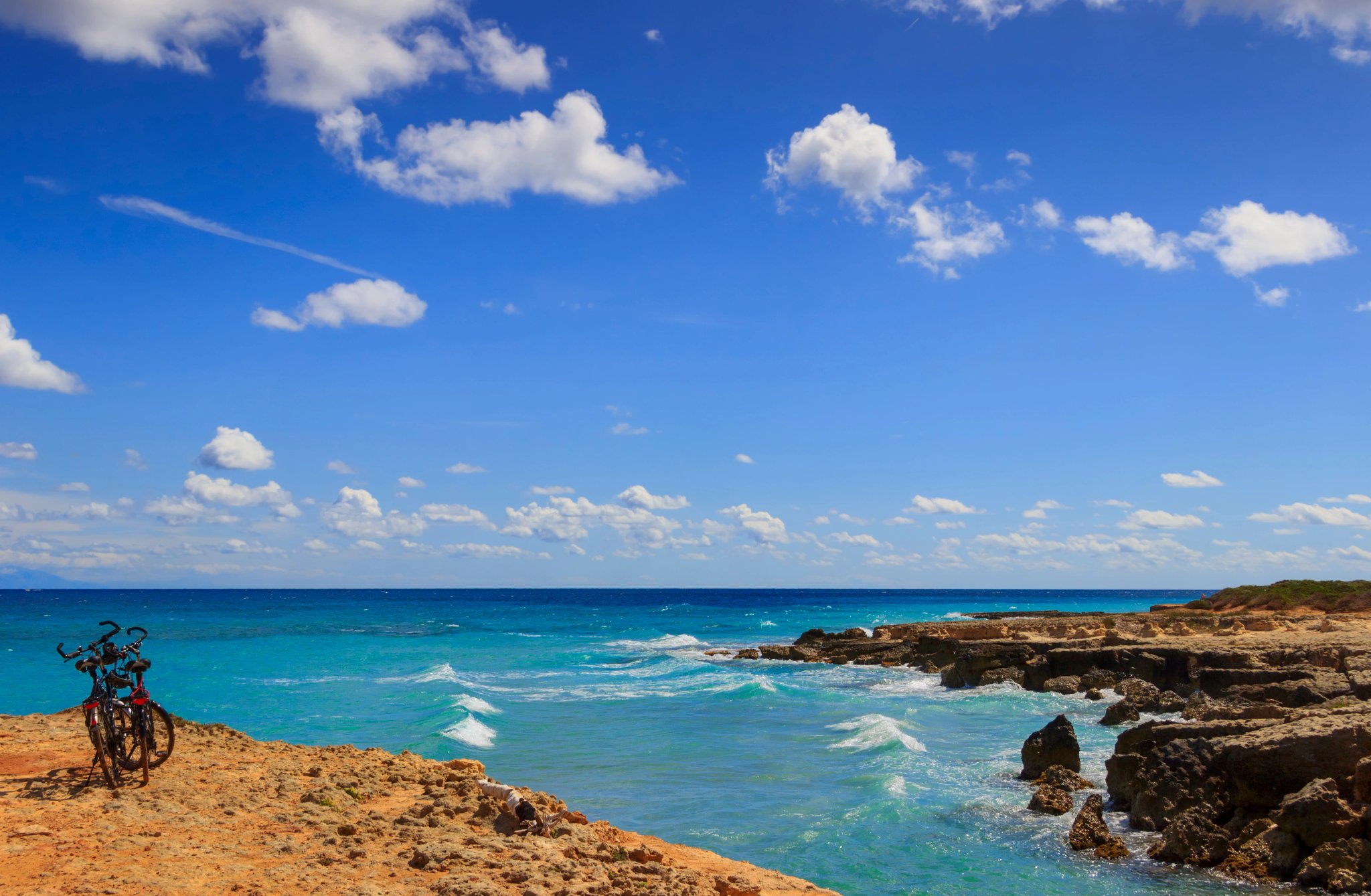
Autumn (September–November)
Autumn is arguably the best cycling season in Puglia. The sea remains warm, the air is clear, and the summer heat fades quickly. September still has lively tourism, but October and November are quieter — perfect for long, relaxed cycling days.
Temperatures: 22–28°C in early autumn, cooling to 15–20°C by November
Best for: Pleasant weather, quieter roads, cultural exploration
Why ride in autumn:
Warm but comfortable temperatures
Excellent visibility for coastal and inland rides
Fewer crowds
Harvest season — ideal for food and wine lovers

Winter (December–February)
Winter is not great for cycling, although Puglia’s coastal areas remain mild, the interior can experience some snowfall. Expect cool mornings, some rain, and generally clear, rideable conditions. The interior and highlands can be colder and unpleasant to ride.
Temperatures: 10–16°C along the coast; colder inland
Best for: Off-season riders, coastal touring, mild winter escapes
Good to know:
Quiet roads and lower accommodation prices
Shorter days and occasional showers
Some services (restaurants, bike shops) may reduce hours
Ideal for peaceful rides if you don’t mind cooler weather
If you’re still keen to ride in the winter, consider warmer destinations - Portugal and Spain (especially the Canary Islands) are a perfect choice for this time of the year!

Top Cycling Routes in Puglia
Puglia offers a remarkably diverse collection of cycling routes, shaped by its long coastline, fertile agricultural plains, limestone plateaus, and UNESCO-listed towns.
The region’s geography makes it possible to ride from the Adriatic to the Ionian Sea, from trulli-covered hills to vineyards, and from medieval citadels to coastal fortifications — all within a few days.
Many of the following routes form the backbone of long-distance cycling journeys across Puglia, including those used on multi-day road bike tours through the region.

Ostuni → Alberobello
A classic Puglian landscape ride. Leaving the bright white hilltown of Ostuni behind, the route rolls through vineyards, orchards, and olive groves before entering the fairy-tale world of trulli architecture near Alberobello. It’s one of Puglia’s most visually distinctive inland journeys.

What to Expect:
Panoramic ridge views from Ostuni at the start
Rolling countryside with short, scenic climbs
Increasing numbers of trulli as you approach Alberobello
Vineyards, cherry orchards, stone farmhouses, and quiet rural lanes
Best For:
Cyclists who enjoy varied landscapes and gentle undulation
Riders drawn to Puglia’s traditional architecture
Anyone seeking an iconic Valle d’Itria experience
This trulli-country traverse is one of the most photogenic inland stages on our Puglia road bike tour.
Trulli Landscapes & Itria Valley Ride
A dreamlike route through the Valle d’Itria, where conical trulli houses, vineyards, and olive groves create one of the most iconic landscapes of southern Italy. Charming whitewashed towns—Locorotondo, Cisternino, Martina Franca—rise from gentle hills, offering panoramic viewpoints throughout the ride.

What to Expect:
Hundreds of trulli across rolling fields
Smooth rural roads lined with dry-stone walls
Vineyards, cherry orchards, and olive groves
Whitewashed hilltowns offering sweeping valley views
Best For:
Cyclists who love classic Puglian scenery
Riders who enjoy gentle undulation and postcard-perfect landscapes
Anyone wanting to experience Italy’s most distinctive rural architecture
This is one of the signature scenic days on the Cycling in the Heart of Puglia tour.
Matera → Altamura
This loop explores two of southern Italy’s most historically rich limestone cities: Matera and Altamura. The ride passes through wheat plains, karst formations, and high limestone shelves typical of the Murgia plateau. Altamura itself is known for its medieval walls and famous sourdough bread.

What to Expect:
Wide open plains of the Alta Murgia
Soft rolling gradients and uninterrupted horizons
Limestone quarries, caves, and karst sinkholes
Medieval streets and Romanesque architecture in Altamura
Best For:
Cyclists who enjoy quiet, spacious landscapes
Riders with an interest in geology and ancient settlements
Anyone wanting a culturally immersive ride with minimal traffic
This scenic inland loop is a defining part of our multi-day cycling loop in the Bari region.
Otranto → Lecce
A visually rich route that blends coast, countryside, and elegant architecture. Starting from Otranto’s medieval harbour, the ride heads inland through olive groves, red-earth farmlands, and citrus gardens before arriving in the Baroque beauty of Lecce.

What to Expect:
Bright coastal light and clear Adriatic air leaving Otranto
Classic Salento scenery: red soil, ancient olive trees, low farm roads
Quiet, flat terrain ideal for relaxed cruising
A stunning arrival into Lecce’s historic golden-stone centre
Best For:
Leisure cyclists and road riders looking for an easy scenic day
Travellers who enjoy combining landscapes with culture
Anyone wanting a photogenic, low-effort ride into a major historic city
This coastal-to-city connection is a favourite linking stage on our Puglia road bike tour.
Gallipoli → Otranto (Salento Coast-to-Coast)
Two seas, two moods, one of the most breathtaking crossings in southern Italy. This ride cuts through the narrow Salento Peninsula, moving from the calm Ionian coast to the rugged Adriatic cliffs. Open views, changing colours, and the dramatic descent into Otranto make it one of the most scenic rides in Puglia.

What to Expect:
Long coastal horizons and turquoise water on both sides of the peninsula
Quiet inland villages, olive groves, and low limestone ridges
A beautiful final approach into Otranto’s medieval harbour
A mix of rural solitude and vibrant seaside scenery
Best For:
Riders who appreciate coast-to-coast variety in a single day
Cyclists looking for visually rich but approachable terrain
Anyone wanting one of Salento’s signature cycling experiences
This iconic crossing is also featured on our Puglia road bike tour as one of the region’s most memorable scenic stages.
Giovinazzo → Castel del Monte
A ride of contrasts — starting beside the Adriatic, ending on a windswept upland beneath a 13th-century castle. The shift from fishing harbours to the vast, open Murge Plateau makes this one of Puglia’s most atmospheric inland routes. Castel del Monte rising from the limestone plain is a visual reward like no other.

What to Expect:
A gentle coastal warm-up followed by long, steady inland gradients
Expansive views across wheat fields and stone-walled farms
The octagonal fortress of Castel del Monte dominating the horizon
Big-sky landscapes with excellent visibility
Best For:
Cyclists who enjoy grand scenery and slow-building drama
Riders comfortable with longer, steady climbs
Anyone interested in Puglia’s most iconic historical landmark
This coastal-to-plateau transition forms one of the signature early stages of our Puglia road bike tour.

Suggested Itineraries
Puglia offers two distinct cycling experiences:
a grand coast-to-coast journey across the entire region and
an inland exploration through trulli villages, ancient cave cities, and the wild grasslands of the Alta Murgia.
Whether you’re chasing long, scenic point-to-point days or prefer immersive rides through cultural landscapes, these curated itineraries showcase the very best of Puglia by bike.
13-Day Cycling Itinerary
Adriatic Coast – Murge Plateau – Matera – Primitivo Wine Country – Ionian Sea – Salento – Valle d’Itria – Bari
This is the ultimate cycling trip in Puglia, riding the full length of Puglia and a loop through the dramatically shifting landscapes. It will take you from the Adriatic coast to the limestone highlands of Castel del Monte, into the canyon-carved city of Matera, through ancient olive groves and vineyards, and across the Salento Peninsula from the Ionian to the Adriatic Sea. Finish with the iconic trulli landscapes of the Valle d’Itria before rolling back to the coast in Bari.
A true coast-to-coast journey through one of Italy’s most diverse southern regions.
Who Is It For?
Intermediate to advanced cyclists
Riders who enjoy long, scenic point-to-point journeys
Cyclists wanting to experience Puglia’s “greatest hits” in one continuous route
Ideal for road and touring cyclists seeking warm-weather riding
Types of Bikes
Road bikes • Touring bikes • E-bikes
Suggested Itinerary
Day 1: Arrival in Giovinazzo
Day 2: Giovinazzo → Castel del Monte (Adriatic coast to limestone plateau)
Day 3: Castel del Monte → Matera (UNESCO canyon city approach)
Day 4: Matera → Crispiano (rural transition from Basilicata into Puglia)
Day 5: Crispiano → Manduria (olive groves & Primitivo wine country)
Day 6: Manduria → Gallipoli (inland to the Ionian Sea)
Day 7: Gallipoli → Otranto (Salento coast-to-coast)
Day 8: Rest Day in Otranto
Day 9: Otranto → Lecce (coastal light & Baroque architecture)
Day 10: Lecce → Ostuni (rolling plains to the “White City”)
Day 11: Ostuni → Alberobello (classic trulli landscapes)
Day 12: Alberobello → Bari (Valle d’Itria descent to the Adriatic)
Day 13: Departure from Bari
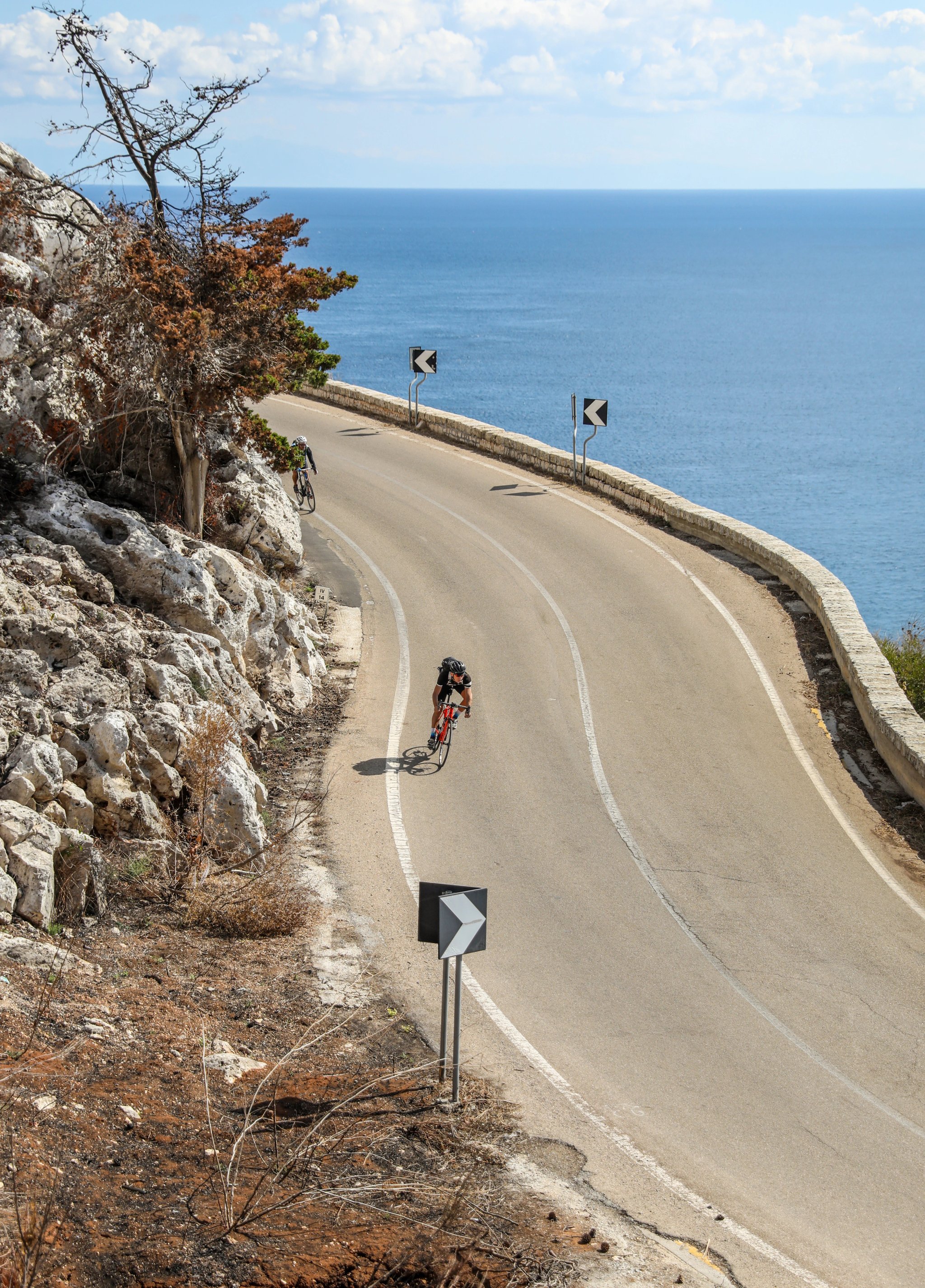
This grand point-to-point route captures the full Puglian experience, from sea to highlands to ancient cave cities — and back to the sea again.
8-Day Cycling Itinerary
Valle d’Itria – Trulli Country – Matera – Altamura – Alta Murgia National Park – Northern Adriatic Coast
An immersive ride through inland Puglia’s most atmospheric landscapes. Cycle among trulli houses, cherry orchards, and dry-stone walls, cross into the dramatic ravines surrounding Matera, explore the Romanesque streets of Altamura, and ride through the wild, windswept grasslands of the Alta Murgia National Park. End with a refreshing coastal finale through Bisceglie, Molfetta, and Giovinazzo.
A route perfect for cyclists drawn to history, geology, and unmistakable southern charm.
Who Is It For?
Leisure to intermediate riders
Cyclists who prefer cultural landscapes over long coastal stretches
Riders who enjoy trulli, caves, ancient towns, wide horizons, and quiet roads
Perfect for touring bikes, gravel bikes, and e-bikes
Types of Bikes
Touring bikes • Gravel bikes • E-bikes
Suggested Itinerary
Day 1: Arrival in Bari
Day 2: Trulli Landscapes & Valle d’Itria (iconic trulli and whitewashed hilltowns)
Day 3: Noci → Matera (rolling interior to canyon city approach)
Day 4: Matera → Altamura Loop (limestone plateaus & medieval streets)
Day 5: Through Alta Murgia National Park (wild, panoramic uplands)
Day 6: Alta Murgia → Northern Bari Coast (descending toward the sea)
Day 7: Coastal Towns: Bisceglie, Molfetta, Giovinazzo (seafront promenades & harbours)
Day 8: Departure from Bari
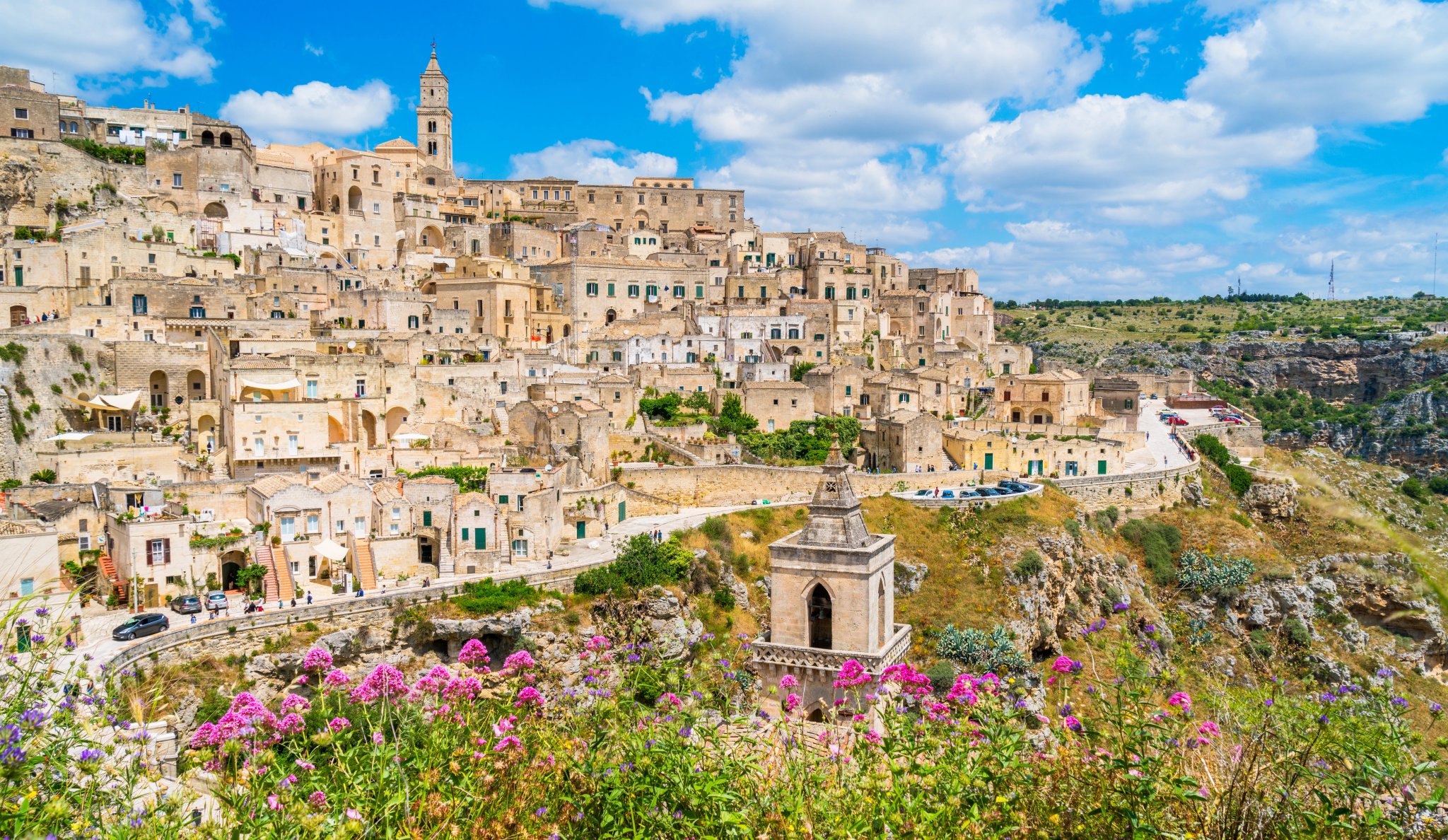
A beautifully balanced journey through trulli country, Matera’s ravines, and the wide-open Murgia highlands, ending with a gentle coastal finish.
Must-See Places in Puglia
Puglia is one of Italy’s most historically layered and geographically diverse regions. Stretching over 400 km from north to south and bordered by two seas—the Adriatic and the Ionian—it offers an unusually high concentration of:
UNESCO sites,
hilltowns,
coastal fortresses,
ancient cave settlements, and
traditional rural architecture found nowhere else in the world.
Below are the places that best capture the character of Puglia (which you also get to see during our cycling tours in Puglia):
Where to Stay in Puglia
Puglia is a long, diverse region shaped by two coastlines and a wide inland plateau, so choosing the right base can significantly enhance a cycling trip.
The best places to stay offer quick access to scenic routes, quiet backroads, cultural sights, and essential cycling amenities like bike storage, repair shops, and easy transfers.
Below are the most cyclist-friendly bases across Puglia — each suited to a different style of riding, from coastal loops to trulli country to wild limestone highlands.
All of our cycling tours in Puglia include cosy and bike-friendly accommodations - so if you ride with us, there’s no hassle of trying to navigate them out on your own.
Best for: Valle d’Itria, trulli landscapes, rolling countryside
Alberobello sits at the heart of the Valle d’Itria and offers immediate access to some of Puglia’s most beautiful inland routes. Its network of quiet, rolling rural roads makes it perfect for leisurely loops and multi-day touring.
Best for: Ridge views, inland-to-coast routes, mixed terrain
The “White City” sits on a panoramic hilltop overlooking olive groves and the Adriatic. This makes it a great base for mixed coastal-and-inland riding with excellent elevation variety.
Best for: Flat, easy rides through Salento + cultural experiences
Lecce combines elegant Baroque streets with flat, accessible terrain. It’s perfect for riders who want scenic but low-effort days, plus a rich cultural and culinary scene.
Best for: Coastal scenery + Salento Peninsula rides
Otranto sits on the Adriatic coast and makes an excellent launch point for dramatic seaside routes, lighthouse roads, and the famous Gallipoli → Otranto crossing.
Best for: Ionian coast, sunset rides, smooth flat loops
Gallipoli offers warm coastal weather, flat terrain, and relaxed seaside cycling. Ideal for those who want maximum sea time paired with low-stress riding.
Best for: Dramatic geology, canyon landscapes, cultural immersion
Just across the regional border in Basilicata, Matera is one of the most atmospheric cycling bases in southern Italy. Its rugged surroundings create unforgettable “edge-of-ravine” riding.
Best for: Flat coastal riding + easy airport access
These towns near Bari are ideal for cyclists seeking a coastal base with simple logistics. They offer scenic promenades, small fishing harbours, and great connections to inland routes.
Cycling Terrain & Road Conditions
Puglia offers some of the most rider-friendly terrain in Italy, with a landscape defined by gentle gradients, long quiet stretches, and excellent visibility.
The region is shaped by two coastlines, a broad central plateau, and rolling inland hills, giving cyclists a mix of flat cruising, scenic ridge lines, and steady—not steep—climbs.
Road surfaces vary from smooth coastal tarmac to rural farm connectors and iconic strade bianche (white gravel roads), allowing both road and gravel cyclists to find routes that suit their style.

Below is a detailed overview of what to expect when riding in Puglia, but if you have any more questions - just reach out.
Overall Terrain Profile
Puglia is known for accessible, consistent, and non-technical terrain—ideal for touring, long days, and leisure riders.
Flat Regions
Salento Peninsula (Lecce, Otranto, Gallipoli)
Southern coastal areas along the Adriatic & Ionian Seas
Northern coast from Bari to Giovinazzo and Molfetta
Expect long, smooth sections with almost no climbing — perfect for warm-up days, e-bikes, beginners, and easy coastal loops.
Rolling Inland Hills
Valle d’Itria (Alberobello, Locorotondo, Cisternino, Martina Franca)
Inner wine regions around Manduria and Crispiano
These hills are short, frequent, and scenic. Elevation changes are constant but gentle, making for engaging “roller-coaster” riding without serious gradients.
Limestone Plateaus & Open Steppes
Alta Murgia National Park
Murge Plateau near Castel del Monte
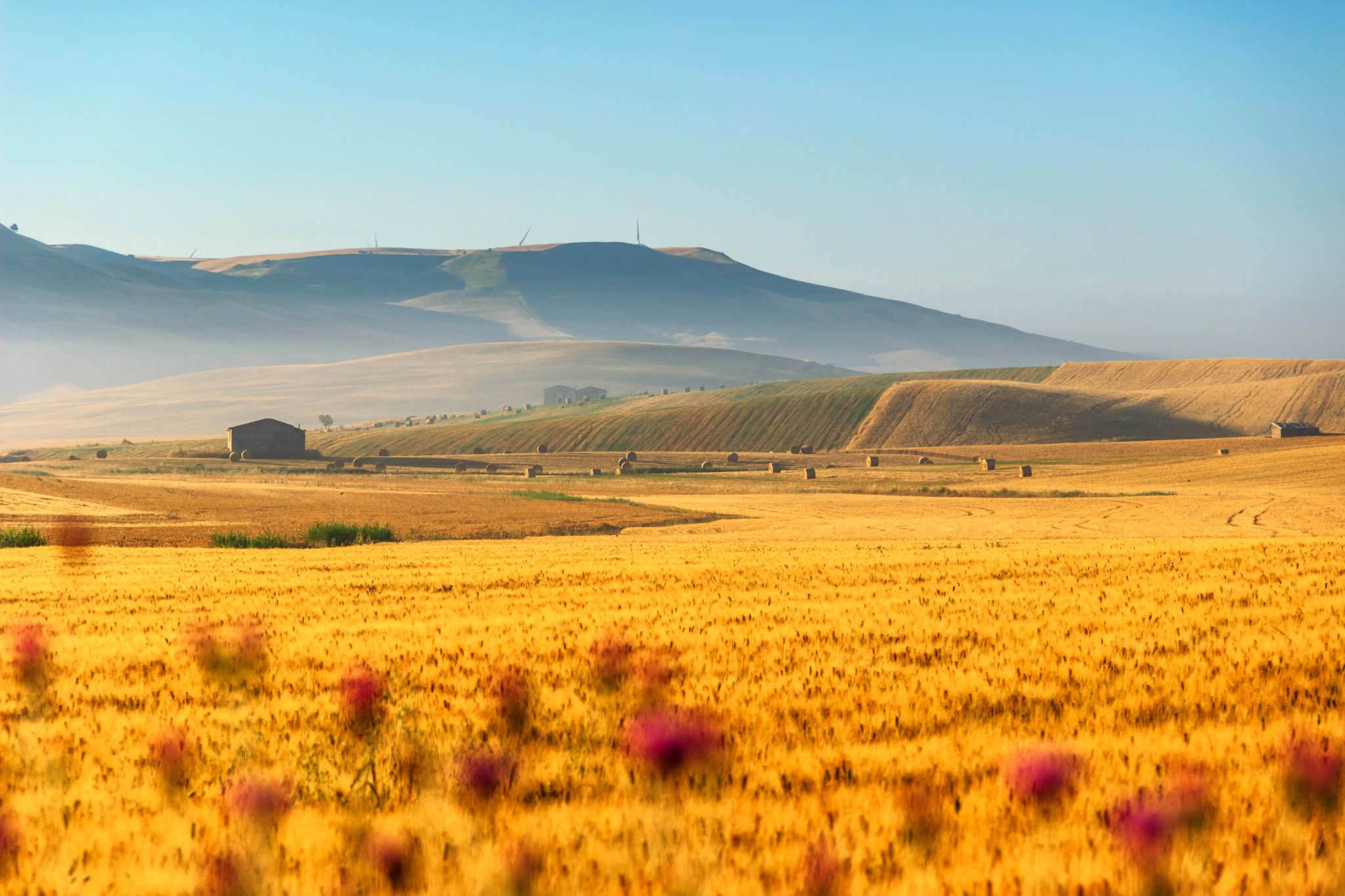
Road Surface Conditions
Coastal Roads
Generally smooth, well-maintained asphalt
Light to moderate traffic depending on the season
Occasional wind exposure and salt spray
Great visibility and wide curves
Ideal for easy kilometres and scenic cruising.
Rural Secondary Roads (Strade Provinciali & Comunali)
The backbone of Puglia’s cycling routes
Asphalt ranges from excellent to lightly worn, depending on agricultural use
Very low traffic
Often lined with dry-stone walls, olive groves, vineyards, and orchards
Perfect for road bikes and touring setups.
These coastal roads make are a big part of cycling our Puglia bike tour.

Strade Bianche (White Gravel Roads)
Common in:
Valle d’Itria
Areas between Ceglie Messapica, Ostuni, Martina Franca
Parts of Alta Murgia
These limestone gravel tracks are:
Hard-packed
Predictable
Mostly non-technical
Ideal for gravel bikes or road bikes with 28–32 mm tyres
They offer some of the most beautiful and peaceful rural riding in Italy. If you’ve ever cycled in Tuscany, you know the feel. If not, we highly recommend it!
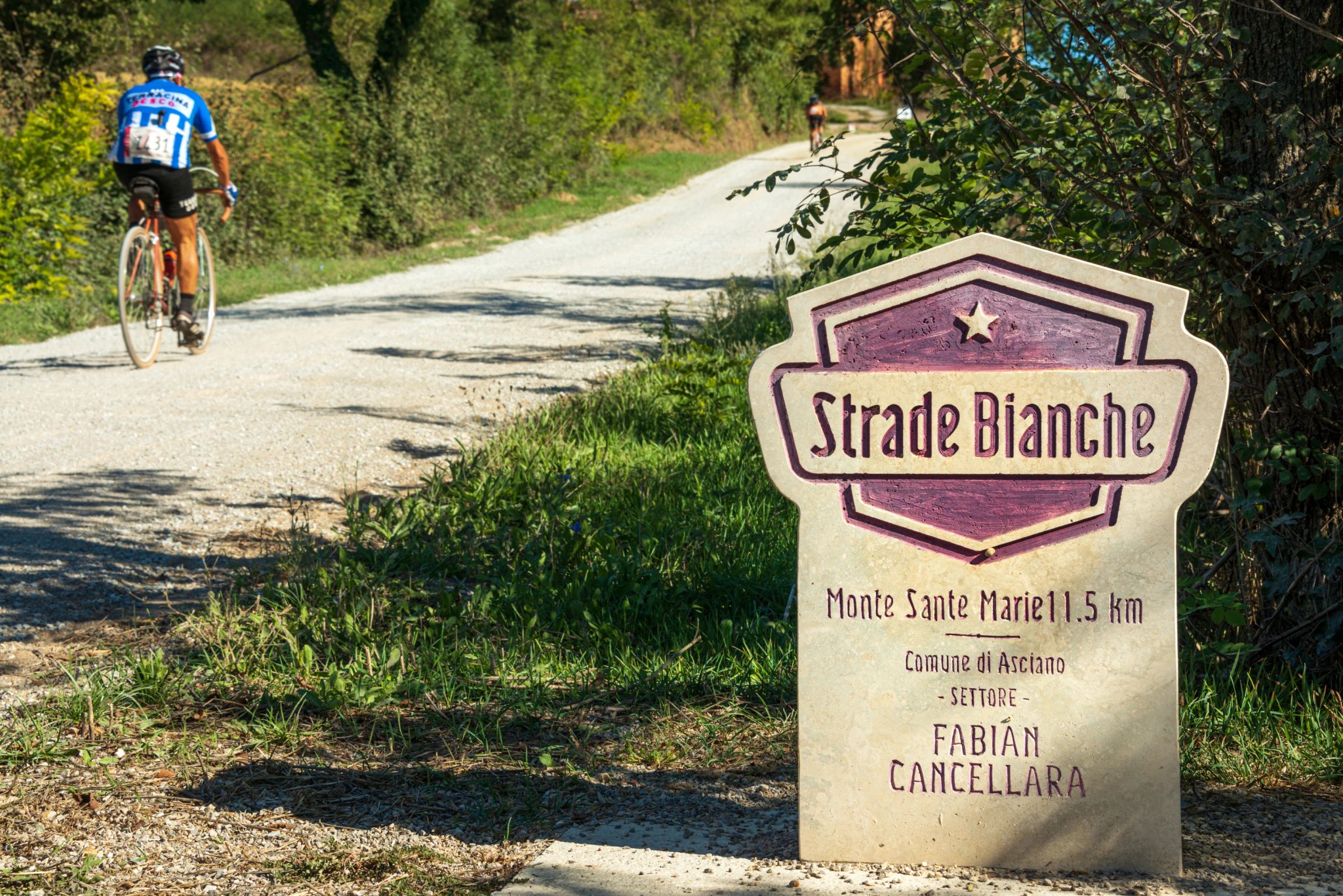
Traffic Conditions
Low-Traffic Areas (excellent for cycling)
Valle d’Itria backroads
Rural routes between Manduria, Crispiano, Martina Franca, Ostuni
Alta Murgia plateau
Inland villages far from the coast
Cyclists often have the road entirely to themselves.
Moderate Traffic
Approaches to major towns like Lecce, Bari, and Taranto
Summer coastal roads near popular beaches
Otranto and Gallipoli during peak season
Still manageable — but early starts are recommended in July & August.
High Traffic (to avoid where possible)
Busy seaside promenades in mid-summer
Main highways (SS roads) — not recommended for cyclists

How to Get to Puglia
Puglia is one of the most accessible regions in southern Italy, well connected by air, high-speed rail, and major highways. Whether you’re arriving from elsewhere in Italy or flying in from abroad, reaching Puglia is straightforward, with convenient options for travellers bringing bikes or renting them locally.
Arriving by Air
Puglia has two international airports:
Bari Karol Wojtyła Airport (BRI) — the main gateway
Largest airport in the region
Excellent connections to Rome, Milan, Venice, Bologna, Naples
Direct flights from major European hubs (London, Paris, Munich, Frankfurt, Amsterdam, Zurich, Vienna, etc.)
Most convenient for cyclists starting in Bari, Giovinazzo, Polignano a Mare, Matera, Valle d’Itria, and the northern coastline
Brindisi Airport (BDS) — better for southern routes
Direct flights from Italy and many European cities
Best for: Salento, Lecce, Otranto, Gallipoli, and the Ionian coast

Arriving by Train
Puglia is well connected to Italy’s national high-speed rail network.
From Northern Italy: Frecciarossa / Frecciargento high-speed trains to Bari
Typical travel times:
Rome → Bari: ~4 hours
Naples → Bari: ~3 hours
Florence → Bari: ~6 hours
Milan → Bari: ~7 hours
Bike considerations:
Foldable bikes are allowed on all trains
Non-folding bikes require regional trains or dedicated bike spaces (availability varies)
Long-distance high-speed trains generally do not carry full-size bikes unless disassembled and bagged
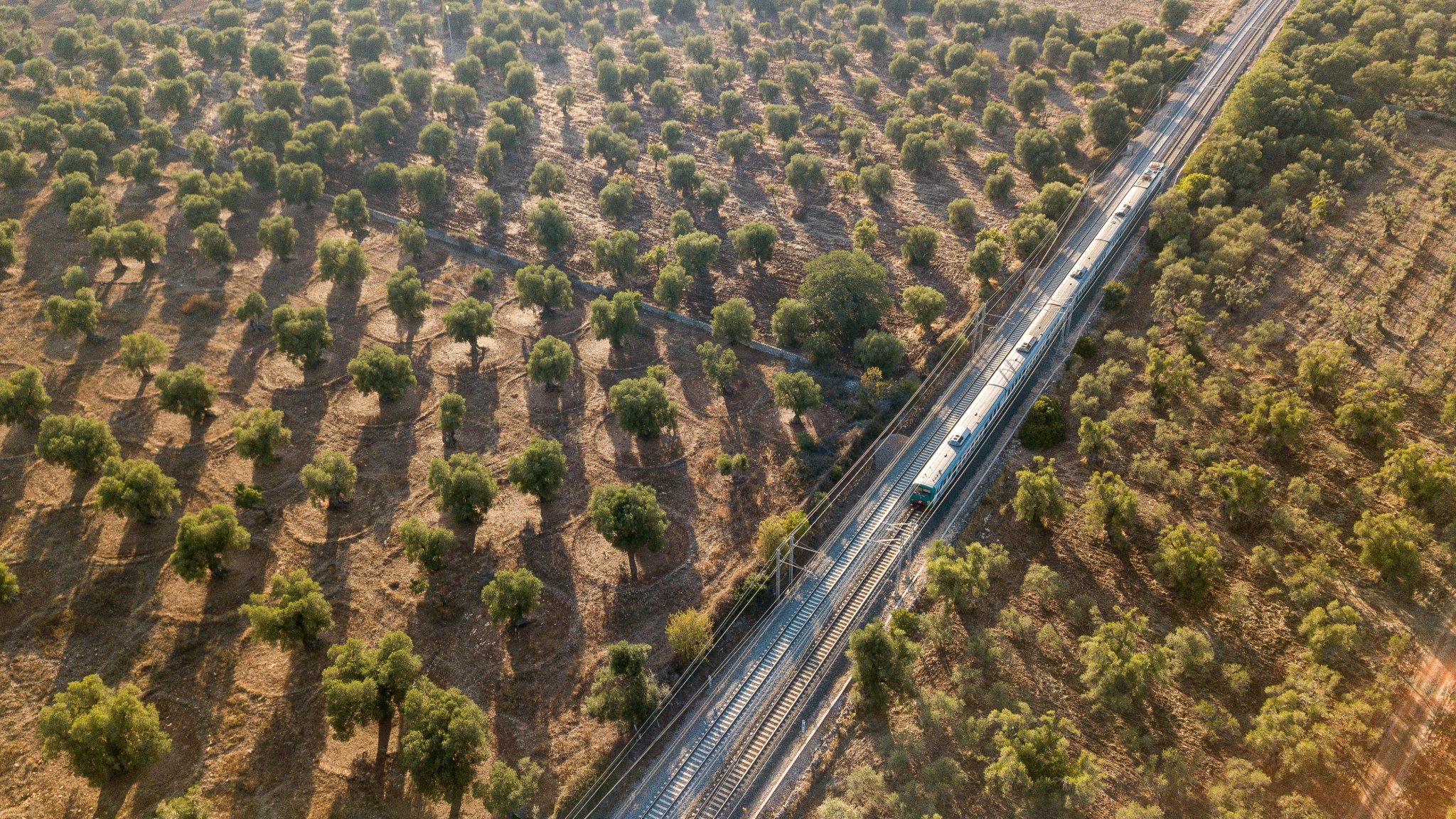
Arriving by Car
The main north–south artery is the A14 Autostrada, which connects:
Bologna → Rimini → Ancona → Pescara → Foggia → Bari → Brindisi → Lecce
Driving is convenient if you plan to:
Bring your own bike
Explore multiple towns with gear
Access remote inland areas like Alta Murgia easily
Parking can be limited in historic centres (ZTLs), but rural areas and masserie have ample space.

Best Cycling Tours in Puglia
From turquoise coastlines to trulli-dotted hills and sunlit olive groves, Puglia is made for unforgettable days on the bike. Here are the tours that capture the region’s beauty, flavours, and effortless southern charm.
Plan Your Puglia Cycling Adventure
Planning a cycling holiday in Puglia is absolutely possible on your own — but the region’s length, inland plateaus, coastal winds, and rural road network often make it more complex than it appears.
Our Puglia cycling tours are carefully designed and refined to highlight the region’s best scenic backroads, historic towns, and diverse landscapes — all while keeping the logistics simple and stress-free.
We take care of the details, including:
Comfortable, cyclist-friendly accommodations
A detailed digital guidebook with daily route notes
GPS tracks for every stage of your tour
Reliable luggage transfers between each stop
Local insights, must-see places, and hidden gems
Full support before and during your trip

Hassle-Free
We handle itineraries, accommodations, and anything else you prefer not to deal with, so you can enjoy a carefree holiday.

Completely Customizable
Flexibility is our middle name — whether you want more or less, or just beyond ordinary, we’ll make it happen.

Book with confidence
We are a financially protected company, fully bonded and insured, keeping your money safe and allowing you to travel with confidence.

Unbeatable support
Our 24/7 customer support is where we show our passion, bringing you a better experience by making your well-being our number one priority.
.jpg&w=3840&q=75)




